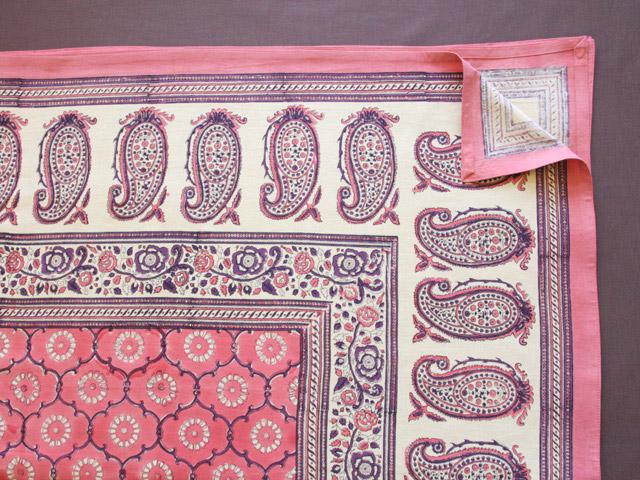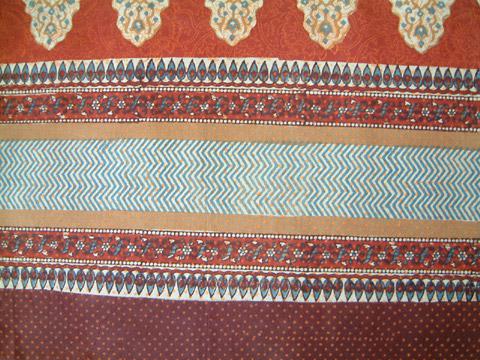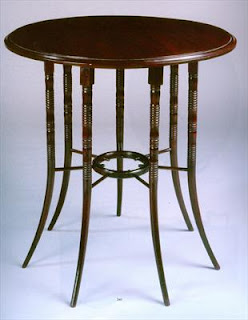.
.
After the AESTHETIC Movement's self proclaimed spokesman ended his bachelorhood at the age of 30, Oscar Wilde and his beautiful wife Constance moved into no.16 Tite Street in Chelsea. Practicing his own doctrine, the Tite Street residence rejected the Victorian heaviness. Objects were selected for their unique qualities- Middle Eastern and Japanese decorations were displayed together- and of course the highly collectible blue and white china held pride of place in the Wilde home. E.W. Godwin, Aesthetic furniture designer was brought in to oversee the decorations for the Wildes.
It turns out that upon initiating the decorations-Oscar took the reins of the of Tite Street project- Surprised? The flamboyantly dressed Wilde wanted to create a Wildeanly restrained residence. Oscar had hoped to enlist James McNeill Whistler-another leading proponent of the Aesthetic movement's
"Art for Art's sake." Whistler had created the famous Peacock Room for Frederick Leyland several years prior to Oscar's marriage. Whistler refused Wilde declaring-
'No, Oscar you have been lecturing to us on the House Beautiful; now is your chance to show us one.'

photograph of Tite Street no16
circa 1910
Chelsea was a bustling neighborhood and no 16 was a Queen Anne style newly built row house. On the ground floor of Tite Street-Oscar's library was just off the entry on the front of the house, with the dining room to the back. The 1st floor of the house was taken up by the couple's drawing room, the upper floors housed three bedrooms and a study set aside for Wilde-that he seldom used.
The use of high-gloss white paint was in abundance at no. 16. The foyer walls and woodwork were a pristine white, the dado was gray and the ceiling- yellow. The stair treads were covered with a straw-coloured matting. W.B Yeats remembered in his Memoirs- the Wilde Drawing Room at no.16.
"It was perhaps perfect in its unity and I remember thinking that the perfect harmony of his life, with his beautiful wife and his two young children, suggested some deliberate composition."
the view of Tite Street in 1887
The Library on the first floor was Oscar's- according to Lord Alfred Douglas it was a smallish one and one could practically peer in from the street level. In reality, perhaps something Lord Alfred was born a bit out of touch with-the room took up half of the ground floor of the residence. Here Oscar Wilde did most of his writing, and here were held-undoubtedly, his most prized possessions- his many books.
Constance with Cyril 1889, age 4
born in 1885-one year after Constance and Oscar married
Vyvyan the second child was born a year later
There are descriptions of the WILDE LIBRARY, but
Alas- no pictures or renderings.
So one must imagine aspects of the Library of Oscar Wilde with its contents-
What follows is a bit of both.
Here are two rooms from the same period the Wilde's Tite Street was decorated-
(below) A drawing room in Highgate 1884 from the book
The Electric Light in Our Homes, Robert Hammond, 1884.
The room appears rid of the Victorian clutter. It is a well to do more current room than many of the day. Less pictures on the walls, light matting on the floor with scattered Persian rugs and a skin. A desk near a sunny window and mix of furniture styles signals a lighter take on decorating.
Another drawling room (below), the Chelsea home of William Bell Scott, from the 1882 book-
Travels in South Kensington, by Moncure Conway. This room is a decidedly more artistic version of a drawing room from the period: casually arranged books on a centrally placed gateleg table, a decorative screen of classical figures, matting on the floor with many Persian carpets laid over it and one rug draped over the arm of a chair, creating a curtain into a library.
So the Wilde Library ?
Above the Library doorway the Wildean Words:
Spirit of Beauty! tarry still awhile
They are not dead,thine ancient votaries,
Some few there are to whom thy radiant smile
Is better than a thousand victories.
(from the Garden of Eros)
The Tite Street Library faced East- the glorious rays of Helios streamed in, but many times Oscar's Moorish screen stood in front of the bay window blocking it. Oscar preferred his rooms more the mellow sort- a more exotic environment for the Muse to tarry.
The design scheme of the Library was to be Moorish in style with dark blues and golds. Godwin's plan called for a 5'6" dado in blue and the walls and ceiling in pale gold, with the woodwork to be a 'golden brown.' Oscar at some point-whether from frustration or preference- changed the blue to a vermilion-likely it was both. Ah, even the great aesthete Wilde did not escape the painfully slow process on his new house. He wrote to Godwin:
'Don't you think a vermilion band in the front room- ground floor, in the recess-to continue the moulding would do for present, till the bookcase is arranged?'
A month later Oscar wrote to Godwin:
'Is it to be vermilion? Is it not? The universe pauses for an answer! Don't keep it waiting.'
Indeed the walls of the Library became Buttercup Yellow- it
'is the colour of Joy.' The dado went Vermilion. The woodwork went from golden brown to a lacquered red brown. Soon after this back and forth, the charming Constance took the reins and things moved a bit faster-with the Wilde couple moving into the residence with still much work to be done.
a colour plate showing wall and ceiling treatment
from the Dresser book, Principles of Decorative Design,1873


perhaps similar to citron of farrow and ball?
picture gallery red from farrow and ball
(the vermilion Oscar was calling for?)
More talk than action -Oscar's own HOUSE BEAUTIFUL broke many of the Aesthetic Movement's dictums. While he touted all- there was no blue and yellow room, no wallpapers. Yeats recollected
"There was nothing pre-Raphaelite, no cupboard with figures upon flat gold, no peacock-blue, no dark background." The friends of Oscar mostly described the Library as Eastern, Turkish or Moorish. He firmly believed the idea of reading a
'volume of Keats...in a library furnished as most are' (badly and tastelessly)- would be an enormous struggle to achieve. His Library needed to be a place of Beauty.
"The object of art is to stir the most divined and remote of the chords which make music in our soul."
The Library was filled with Oscar's locked away valuable Greek Classics, his over 2000 volumes, 19th century novels, periodicals, portfolios and precious poetry volumes. Many books were oversized- like his
Cyclopaedia of Costume. Binding colours meant little to the aesthetic of Oscar's own library, though his advice to others was to curtain the books that were not harmonious to the overall decoration of their own libraries. Oscar's most prized possession in the Library was his desk-once owned by Thomas Carlyle. Carlyle, historian and philosopher was a resident of Chelsea as well, Oscar had once visited with the much admired man in his home.The writing desk was probably acquired by Oscar through an antique dealer selling some of Carlyle's pieces when he died in 1881. Wilde had read Carlyle extensively, he was one of Oscar's mother's favourites and quoted passages from memory. Oscar held the desk in reverence and it is evidenced that he believed it to be his own literary talisman.
a drawing of Carlyle at his desk
Other furnishings in the Library centered around a highly ornate oak mantel and fireplace surround,, an antique sofa covered in moreen, chairs; a Chippendale mahogany corner chair, an antique ivory inlaid elbow chair and a comfortable easy chair. Additionally an old oak carved chest, a red tiered what not stand, a revolving walnut bookcase and ottomans sitting about. Warming the floors- an 8 x 7 Persian carpet and a rug of sheepskin.
Here-a look at what might have been.
a metalworks showroom with elaborate mantels and
fireplace surrounds on display with its andirons
an antique Irish Chippendale chair
a chair from the period
an E.W Godwin display cabinet
a Godwin designed table
a 19th c. revolving bookcase
carpet from the period
what Aesthetic room would be complete without the blue and white china, Oscar collected-
'I find it harder and harder to live up to my blue china'
The 1862 Japanese display from the International Exhibition in London was the year the British public on a whole was introduced to and fell in love with Japanese art and artifacts. Country houses had collections of export porcelain but it was a possession owned mostly by the wealthy. Designers were inspired by the porcelains shown in the exhibit they saw and began creating their own versions in the Japanese style. Many of the finest imported Japanese pieces that artist Dante Gabriel Rossetti & James McNeill Whistler began collecting were to be found at Murray Marks. Marks was the foremost dealer and expert in the much sought after blue and white Nankin porcelain. The large cobalt ginger jars with prunus blossoms falling on ice were named Hawthorne pots by Rossetti. The designer for the Wildes, E. W Godwin, was often on hand when a shipment was expected at Murray Marks.
The collection below is representative of the porcelains sought out when the Wilde's were in residence at Tite Street.


In 1882, at the age of 28, Oscar wrote of his
'irresistible desire to wander, to go to Japan, where I will pass my youth, sitting under an almond tree in white blossom, drinking amber tea out of a blue cup, and looking at a landscape without perspective.
Oscar's most personal art work was arranged in his Library on the few walls available for them.
On the walls in the Library at no.16:
a Beardsley drawing of the actress Mrs. Patrick Campbell
a painting by Adolphe Monticelli (this one exemplary of the artist's work-not the actual painting Oscar Wilde owned)
a Japanese painting of children playin
g (again this an example of one of the period)
a picture by the pre-Raphaelite artist Simeon Solomon-perhaps like this one by Solomon The Virgin Knight.
"A picture has no meaning but its beauty, no message but its joy.
That is the first truth about art that you must never lose sight of.
A picture is a purely decorative thing.” Oscar Wilde
“No object is so ugly that, under certain conditions of light and shade, or proximity to other things, it will not look beautiful; no object is so beautiful that, under certain conditions, it will not look ugly. I believe that in every twenty-four hours, what is beautiful looks ugly, and what is ugly looks beautiful, once.” Oscar Wilde from his Lecture to Art Students
One of Oscar's favourite pieces was an impressive Hermes bust taken from the Greek sculptor Praxiteles' Hermes.
Praxiteles Hermes
The original Hermes- Oscar saw in 1877 on a trip to Greece. He was sure
'the spirit of the god still dwelt within the marble.' Oscar's plaster cast of Hermes was displayed on a red lacquered tripod in the Wilde Library. The god of poets, orators and the conductor of souls, the Praxiteles Hermes carries the infant god Dionysus- the Greek god of fertility. Dionysus, inspiring ecstasy or violent passion,also considered a patron of the arts, was the only god with a mortal parent. This too, must have intrigued Wilde-representing the complex duality of Man- Himself.
Rounding out the library: a mirror-Oscar loved the way they caught the light of candles, a Chinese lantern, Japanese masks, brass lamps, brackets, Japanese baskets and bronzes.
Oscar's guests and friends would have been invited into the library where Oscar held court- reading aloud to friends- his own work or that of others. Moving about the room, a cigarette in hand, full of energy, Oscar's life momentarily in perfect harmony. In just over 10 years living at Tite Street Oscar lost it all.Public accusations of his affair with Lord Alfred Douglas, a public trial, his bankruptcy, his imprisonment, his loss of family, Constance's death, his exile, left Oscar Wilde a broken man.
'I believe I am to have enough to live on for about eighteen months at any rate, so that if I may not write beautiful books, I may at least read beautiful books; and what joy can be greater? After that, I hope to be able to recreate my creative faculty.'
From
Oscar Wilde's De Profundis
The 2000 books in the library were sold for 130 pounds
: My library with its collection of presentation volumes from almost every poet of my time; its beautifully bound editions of my father's and mother's works. The Wilde possessions began appearing in Chelsea area shops after the sale- the Carlyle writing table, the Wilde children's toys, their books and their large paper edition of Oscar's
The Happy Prince- that their father read aloud to them. The House Beautiful was lost.
After Wilde was released from prison, he survived three years-self exiled, living with friends on the continent or in shabby hotels. He never lost his sharp wit, and when he was mortally ill remarked:
‘My wallpaper and I are fighting a dual to the death. One or other of us has to go.’
He was 46 years old when he died.
the official web site of OSCAR WILDE
here
read more about Whistler's Peacock Room at John Coulthart's feuilleton
John Coulthart's Wildeana post
here
read more about Oscar Wilde's life at Willowbrook Park
here
.






































_1889,_May_23._Picture_by_W._and_D._Downey.jpg)



















